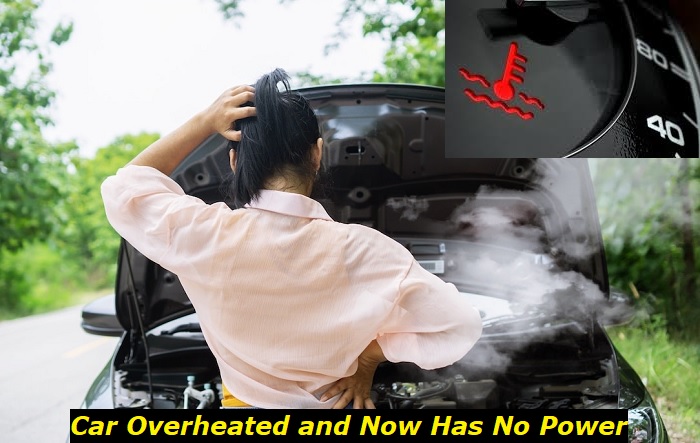Typically, the temperature gauge in automobiles tends to sit somewhere around the middle after running the engine for a while. The car reaching the upper limit of its ideal temperature is a tell-tale sign of engine overheating. An engine overheating is problematic for any vehicle owner as it poses a danger to the driver, nearby people, and property. Also, excessive heat could cause permanent damage to the engine in a short while, and replacing a dead engine is costly.
Engine overheating highlights
- Level of urgency:very high
- Commonreasons:low coolant, thermostat problems, coolant blockage, radiator fan problem
- DIY diagnostics:possible but complicated
- DIY repair:impossible
- Price of repair:$300 - $650
- Time for repair:3 - 6 hours
- If ignored:engine failure, low performance, cooling equipment damage

Overheating And Power Loss: Possible Causes
Several things can lead to your car overheating and losing power. We discuss them below.
1) Problem With the Radiator
A car often overheats because of a problem with the radiator, which is the centerpiece of the engine's cooling system. A running engine can cause up to 15 explosions per second in each cylinder, generating much heat. The radiator handles the regulation of that heat.
In doing so, the radiator relies on engine coolant that contains a mixture of water and antifreeze. The coolant circulates throughout the engine, engine cylinders, and the radiator and absorbs the heat.
Further, the radiator has fins and tubes through which the heated coolant passes. The pipes and fins lower the temperature of the coolant as air blows on it. After the coolant's temperature falls, it flows back to the engine to absorb more heat. Suppose the radiator is not working; the car's engine will likely overheat if it is on for an extended period.
2) Low Coolant Level
Low coolant levels in the radiator will increase the chances of your engine overheating and losing power. Over time, as the coolant gets heated up and cooled, it will depreciate. Without adequate coolant to cool the engine, it will likely overheat. It is a good idea to check the coolant level in your radiator occasionally and top it up when it drops.
3) Leaks
Coolant levels may frequently drop if there is a leak in the radiator, hose, or radiator cap. A leaking radiator, hose, or radiator cap will cause the coolant within the radiator to drop fast. There might be a leak if you find yourself topping up the radiator with coolant too often. You must identify and fix the source of the leak.
4) Faulty Thermostat
A malfunctioning thermostat is another reason why the engine overheated. Based on a specified temperature, the thermostat regulates how the engine cools. Wear, contaminated fluid, collapsed hose, faulty water pump, or failed radiator can damage the thermostat, preventing it from opening or closing up when necessary, resulting in overheating.
5) Damaged Radiator Fan
The radiator lowers the temperature of the coolant through the air that blows on its fins. The fan sits between the radiator and the engine and helps provide that air. Now, while air blows on the radiator as you drive, that air is not always adequate, especially when the car is stationary or driven slowly. So, radiator fans are a very significant part of the cooling system. A fault with the fan could reduce the efficacy of the radiator in cooling the coolant, thus resulting in overheating.
6) Bad Water Pump
The water pump propels the movement of the coolant through the hoses across the engine and radiator. Thus, if the water pump does not move the coolant, there is no way the cooling system will work. Consequently, the engine may overheat if the cooling system is not working.
7) Failed Head Gasket
One sign of a blown gasket is the engine overheating. So also, a blown gasket worsens overheating in the engine. The head gasket performs the crucial role of preventing coolant and oil from mixing within the engine. An out-of-sort head gasket requires the engine to work harder to generate power, causing it to overheat. Additionally, a blown gasket can reduce coolant in the car, further aggravating the overheating issue.
8) Failing Serpentine Belt
The serpentine belt is also called the drive belt. It powers the air conditioning, power steering, alternator, and sometimes the cooling system water pump. Its effect on the cooling water pump is what concerns us here.
The serpentine belt is always in operation when the engine is on. Suppose your car uses the serpentine belt to power the water-cooling pump. In that case, a faulty serpentine belt will stop the cooling system from working and lead to overheating for such vehicles. Lastly, a defective serpentine belt will likely prevent the engine from starting.
Each identified issue could cause overheating and power loss. Yet, each case requires different diagnostic procedures and repairs. Calling your mechanic's attention could be the most reliable way to solve this issue.
Symptoms Of an Overheating Car
When it comes to your car overheating, there are a few things that should capture your attention; they include:
- The temperature gauge is at its upper limit, in the red area, usually marked with an "H."
- Steam or gray vapor emanates from the hood/bonnet. The steam may look like smoke.
- The engine temperature light illuminates. This light is sometimes called the "idiot light." If it is on, your engine is overheating.
- The smell of something burning comes from the hood/bonnet. Many people describe the smell as "hot."
- Excessively hot hood. The car's hood is usually warm after the engine has run for a while and in hot weather. But an overheating engine can exacerbate the effect to the extent that touching the car's hood is very uncomfortable.
Overheating Car: What to Do
An overheating car is not something to trifle with as it portends danger for you, other drivers, and anyone else around. If you notice any of the symptoms mentioned above of overheating, here is what you should do:
- Switch off your air conditioner if it is on as it puts more stress on the engine's cooling system, sustaining or heightening the high temperature.
- Turn the heater on to the max. Turning the heater on will help pull some heat away from the engine.
- Pull over as soon as possible, away from other people and cars, and turn the engine off. Do not attempt to drive home or to a mechanic; this would be a mistake. The longer you drive an overheating engine, the more likely it is to suffer permanent damage. The car's engine is usually the costliest part to replace.
- At this point, we recommend calling a mechanic for roadside help. But, if you would instead troubleshoot the problem yourself, read on.
- Leave the car for at least 20 minutes so it can cool. Avoid opening the hood immediately after shutting off the engine. Because opening up the hood right after you pull over could cause burns and injuries from the hot steam to your person or anyone else around.
- After waiting at least 20 minutes, you can open the hood and check the coolant level. If it is low, try topping it up with coolant. If you do not have coolant, you can use water.
- If the coolant levels are okay after checking it or you have topped it up, wait for the engine to return to its average temps before driving it again. Watch the temperature gauge while driving your car, to a mechanic, for proper diagnosis and repair.
- If the car does not start after, even with the engine cooling off and the coolant level adequate, you will need a towing service to get the car to an auto repair shop.
How To Prevent Overheating and Power Loss
Regular maintenance is the only way to prevent your car from overheating. Get your car regularly serviced by experts to guarantee the efficacy of the cooling system and other car parts.
Also, there are warning signs from your vehicle that indicate you need to address an issue. For example, do not ignore a check engine light or unusual sounds emanating from the engine.
Furthermore, some cars need a coolant flush after the car's mileage has reached a set number. Check with your car's manual for how often you need the coolant flushed.
Additionally, it would help to inspect your car's coolant level at least once every six months to ensure it is enough. P.S. Checking the coolant levels more often will not cost you anything.
Conclusion
To sum up, overheating and a loss of power could result from several factors. You need to be able to identify the symptoms of an overheating car. Because failure to know when your engine is overheating could be dangerous and costly.
One way to prevent an overheating engine is to get your car regularly serviced and pay attention to warning signs from your vehicle. If your car overheats, ensure you pull over, turn off the engine, and follow the steps outlined. Alternatively, if those steps are too much of a hassle or the car has no power, we recommend getting the service of an authorized auto mechanic to prevent further damage.
About the authors
The CarAraC research team is composed of seasoned auto mechanics and automotive industry professionals, including individuals with advanced degrees and certifications in their field. Our team members boast prestigious credentials, reflecting their extensive knowledge and skills. These qualifications include: IMI: Institute of the Motor Industry, ASE-Certified Master Automobile Technicians; Coventry University, Graduate of MA in Automotive Journalism; Politecnico di Torino, Italy, MS Automotive Engineering; Ss. Cyril and Methodius University in Skopje, Mechanical University in Skopje; TOC Automotive College; DHA Suffa University, Department of Mechanical Engineering






Add comment